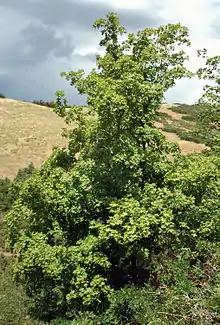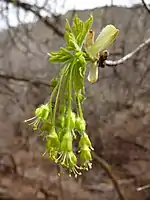Acer grandidentatum
Acer grandidentatum, commonly called bigtooth maple, is a species of maple native to interior western North America. It occurs in scattered populations from western Montana to central Texas in the United States and south to Coahuila in northern Mexico.
| Acer grandidentatum | |
|---|---|
 | |
| Bigtooth maple, Wasatch Mountains, Utah | |
| Scientific classification | |
| Kingdom: | Plantae |
| Clade: | Tracheophytes |
| Clade: | Angiosperms |
| Clade: | Eudicots |
| Clade: | Rosids |
| Order: | Sapindales |
| Family: | Sapindaceae |
| Genus: | Acer |
| Species: | A. grandidentatum |
| Binomial name | |
| Acer grandidentatum | |
 | |
| Generalized natural range | |
Description
It is a small to medium-sized deciduous tree growing to 10–15 m (33–49 ft) tall and a trunk of 20–35 cm (8–14 in) diameter. The bark is dark brown to gray, with narrow fissures and flat ridges creating plate-like scales; it is thin and easily damaged. The leaves are opposite, simple, 6–12 cm (2 1⁄4–4 3⁄4 in) long and broad, with three to five deep, bluntly-pointed lobes, three of the lobes large and two small ones (not always present) at the leaf base; the three major lobes each have 3–5 small subsidiary lobules. The leaves turn golden yellow to red in fall (this trait is less reliable in warmer areas).
The flowers appear with the leaves in mid spring; they are produced in corymbs of 5–15 together, each flower yellow-green, about 4–5 mm (3⁄16–3⁄16 in) diameter, with no petals. The fruit is a paired samara (two winged seeds joined at the base), green to reddish-pink in color, maturing brown in early fall; each seed is globose, 7–10 mm (1⁄4–3⁄8 in) diameter, with a single wing 2–3 cm (3⁄4–1 1⁄4 in) long.
 Flowers and emerging spring leaves in early April in Salt Lake County, Utah
Flowers and emerging spring leaves in early April in Salt Lake County, Utah Mature summer leaves in August
Mature summer leaves in August_-_Little_Cottonwood_Canyon%252C_Utah_(2003).jpg.webp) Fall leaf color in late September
Fall leaf color in late September
Taxonomy
It is closely related to Acer saccharum (sugar maple), and is treated as a subspecies of it by some botanists, as Acer saccharum subsp. grandidentatum (Nutt.) Desmarais.[2][3]
Distribution and habitat
It commonly grows in limestone soils but can adapt to a wide range of well-drained soils, from sand to clays to even white limestone areas. It prefers sheltered canyons, valleys, and the banks of mountain streams, primarily at higher elevations but occasionally at lower elevations in disjunct locales such as the southern edge of the Edwards Plateau in Texas and in the Wichita Mountains of southwestern Oklahoma.
Cultivation
Although it is found in continental climate over all of its natural range, planted specimens grow well in the maritime climate of Vancouver. It is slow growing when young, and does not have many pests.
It is occasionally planted as an ornamental tree, valued for its drought tolerance and ability to grow in rocky landscapes.
Uses
The sweetish sap is used in western North America to make maple sugar.[4]
See also
References
- "Acer grandidentatum". IUCN Red List of Threatened Species. 2019. 2019. Retrieved 16 June 2019.CS1 maint: ref=harv (link)
- "Acer grandidentatum". Natural Resources Conservation Service PLANTS Database. USDA.
- "Acer grandidentatum". Germplasm Resources Information Network (GRIN). Agricultural Research Service (ARS), United States Department of Agriculture (USDA). Retrieved 1 January 2018.
- Whitney, Stephen (1985). Western Forests (The Audubon Society Nature Guides). New York: Knopf. p. 393. ISBN 0-394-73127-1.
External links
 Media related to Acer grandidentatum at Wikimedia Commons
Media related to Acer grandidentatum at Wikimedia Commons
